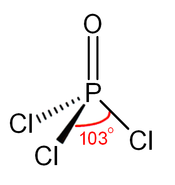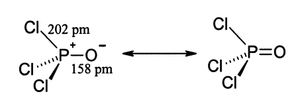Phosphoryl chloride

| |||
| |||
| Names | |||
|---|---|---|---|
| IUPAC names
Phosphoryl trichloride
Phosphorus trichloride oxide | |||
| Other names
Phosphorus oxychloride
Phosphoric trichloride | |||
| Identifiers | |||
3D model (JSmol)
|
|||
| ChemSpider | |||
| ECHA InfoCard | 100.030.030 | ||
| EC Number |
| ||
PubChem CID
|
|||
| RTECS number |
| ||
| UN number | 1810 | ||
CompTox Dashboard (EPA)
|
|||
| |||
| |||
| Properties | |||
| POCl3 | |||
| Molar mass | 153.33 g/mol | ||
| Appearance | Clear, colourless liquid, fumes in moist air | ||
| Density | 1.645 g/cm3, liquid | ||
| Melting point | 1.25 °C (274.4 K) | ||
| Boiling point | 105.8 °C (379.0 K) | ||
| Reacts | |||
| Structure | |||
| tetrahedral | |||
| 2.54 D | |||
| Hazards | |||
| NFPA 704 (fire diamond) | |||
| Related compounds | |||
| Supplementary data page | |||
| Phosphoryl chloride (data page) | |||
Except where otherwise noted, data are given for materials in their standard state (at 25 °C [77 °F], 100 kPa).
| |||
Phosphoryl chloride (commonly called phosphorus oxychloride) is a colourless liquid with the formula Template:PhosphorusTemplate:OxygenTemplate:Chlorine3. It hydrolyses in moist air to phosphoric acid to release choking fumes of hydrogen chloride. It is manufactured industrially on a large scale from phosphorus trichloride and oxygen or phosphorus pentoxide. It is mainly used to make phosphate esters such as tricresyl phosphate.
Structure
Like phosphate, phosphoryl chloride is tetrahedral in shape. It features three P-Cl bonds and one very strong P=O double bond, with an estimated bond dissociation energy of 533.5 kJ/mol. On the basis of bond length and electronegativity, the Schomaker-Stevenson rule suggests that the double bond form is very dominant (in contrast with POF3). The P=O bond does not resemble the π bond in a carbonyl group as in a ketone. The appropriate description of the P-O interaction is a matter of long discussion. Older textbooks favor a description that invokes participation of the d-orbitals on phosphorus. Some of these d-orbitals project toward the O atom, overlapping with p-orbitals on oxygen. More modern texts seem to favor a description where the P-O π bonding involves the σ* components of the P-Cl bonds. These descriptions do not consider a role for d-orbitals.
- where pm = picometers
Chemical properties
POCl3 reacts with water and alcohols to give hydrogen chloride and phosphoric acid or phosphate esters, respectively:
- O=PCl3 + 3 H2O → O=P(OH)3 + 3 HCl
If the water is replaced by an alcohol, the trialkyl phosphate esters result. Such reactions are often performed in the presence of an HCl acceptor such as pyridine or an amine. If POCl3 is heated with an excess of a phenol (ArOH) in the presence of a Lewis acid catalyst such as magnesium chloride, a triaryl phosphate ester such as triphenyl phosphate is formed. For example:
- 3 C6H5OH + O=PCl3 → O=P(OC6H5)3 + 3 HCl
POCl3 can also act as a Lewis base, forming adducts with a variety of Lewis acids such as titanium tetrachloride:
- Cl3P+-O− + TiCl4 → Cl3P+-O−-TiCl4
The aluminium chloride adduct (POCl3·AlCl3) is quite stable, and so POCl3 can be used to remove AlCl3 completely from reaction mixtures at the end of a Friedel-Crafts reaction. POCl3 reacts with hydrogen bromide in the presence of AlCl3 to produce POBr3.
Preparation
Phosphoryl chloride can be prepared by the reaction of phosphorus trichloride with oxygen at 20-50 °C (air is ineffective):
- 2 PCl3 + O2 → 2 O=PCl3
An alternative synthesis involves the reaction of phosphorus pentachloride (PCl
5) and phosphorus pentoxide (P
4O
10). Since these compounds are both solids, a convenient way of performing the reaction is to chlorinate a mixture of PCl3 and P4O10, which generates the PCl5 in situ. As the PCl3 is consumed, the POCl3 becomes the reaction solvent.
- 6 PCl3 + 6 Cl2 → 6 PCl5
- 6 PCl5 + P4O10 → 10 POCl3
Phosphorus pentachloride also forms POCl3 by reaction with water, but this reaction is less easily controlled than the above reaction.
Uses
The most important use for phosphoryl chloride is in the manufacture of triarylphosphate esters (as described above) such as triphenyl phosphate and tricresyl phosphate. These esters have been used for many years as flame retardants and plasticisers for PVC. Meanwhile trialkyl esters such as tributyl phosphate (made similarly from butan-1-ol) are used as liquid-liquid extraction solvents in nuclear reprocessing and elsewhere.
In the semiconductor industry, POCl3 is used as a safe liquid phosphorus source in diffusion processes. The phosphorus acts as a dopant used to create N-type layers on a silicon wafer.
In the laboratory, POCl3 is widely used as a dehydrating agent, for example the conversion of amides to nitriles. Similarly, certain aryl amides can be cyclised to dihydroisoquinoline derivatives using the Bischler-Napieralski reaction.
Such reactions are believed to go via an imidoyl chloride; in certain cases where it is stable, the imidoyl chloride is the final product. For example pyridones and pyrimidones can be converted to chloro- derivatives of pyridines and pyrimidines, which are important intermediates in the pharmaceutical industry.[1]
See also
References
- ^ R. C. Elderfield, Heterocyclic Compounds, Vol. 6, p 265
Further reading
- N. N. Greenwood, A. Earnshaw, Chemistry of the Elements, 2nd ed., Butterworth-Heinemann, Oxford, UK, 1997.
- Handbook of Chemistry and Physics, 71st edition, CRC Press, Ann Arbor, Michigan, 1990.
- J. March, Advanced Organic Chemistry, 4th ed., p. 723, Wiley, New York, 1992.
- The Merck Index, 7th edition, Merck & Co, Rahway, New Jersey, USA, 1960.
- A. D. F. Toy, The Chemistry of Phosphorus, Pergamon Press, Oxford, UK, 1973.
- L. G. Wade, Jr., Organic Chemistry, 6th ed., p. 477, Pearson/Prentice Hall, Upper Saddle River, New Jersey, USA, 2005.
- B. J. Walker, Organophosphorus chemistry, p101-116, Penguin, Harmondsworth, UK, 1972.





